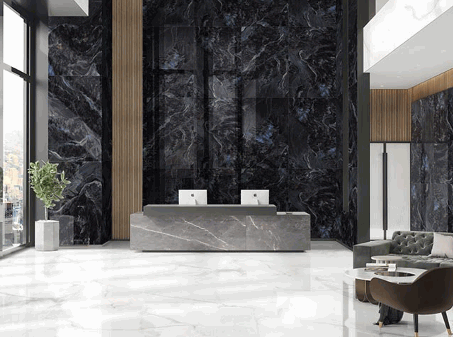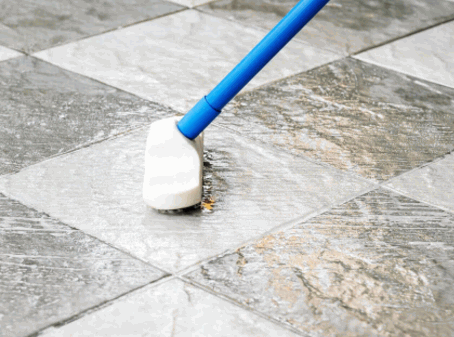
When selecting appropriate flooring for commercial environments, a variety of tile options are available, each offering distinct advantages. The choices range from fashionable ceramic and resilient porcelain tiles to adaptable vinyl and sophisticated natural stone, which can create a sense of overwhelm. However, if one wishes to revitalise existing tiles without the need for replacement, this article examines the viability of painting commercial floor tiles. It outlines essential factors to consider, necessary preparation steps, and effective maintenance recommendations. This exploration will determine whether painting commercial floor tiles represents a prudent decision that can enhance the aesthetic appeal of the space.

Table of Contents
In commercial environments, a variety of floor tiles are employed for their durability, aesthetic appeal, and ease of maintenance.
Ceramic tiles are particularly popular due to their strength and the wide range of available colours. Porcelain tiles are also preferred for their low water absorption, making them suitable for high-traffic areas and ideal for tile backsplashes and painted floors.
Vinyl tiles present a cost-effective alternative that is both easy to install and maintain, whereas natural stone tiles offer a distinctive and luxurious appearance, albeit with the potential for increased maintenance requirements.
Ceramic tiles are regarded as a versatile and popular flooring option for commercial environments, primarily due to their remarkable durability and extensive range of design possibilities, making them a great option for decorative stencils and painted tile benefits.
These tiles are distinguished not only by their resilience but also by their practicality, making them a preferred choice among various flooring materials.
In summary, opting for ceramic tiles as a flooring solution can significantly enhance both the functionality and visual appeal of any space, delivering long-lasting results that fulfill the requirements of any commercial setting.

Porcelain tiles, recognised for their high density and water resistance, are well-suited for both low and high-traffic commercial settings and are excellent for paint tile applications to enhance their floor aesthetics.
This exceptional flooring option not only endures the wear and tear typical of bustling environments but also provides an extensive array of designs and colours. Businesses aiming to enhance their atmosphere will find that porcelain tiles can seamlessly complement any aesthetic, ranging from contemporary to classic styles.
These tiles require minimal maintenance; regular sweeping and occasional mopping with a mild detergent are sufficient to maintain their pristine condition. The impressive durability of porcelain allows it to resist scratches and stains, making it a prudent choice for locations experiencing significant foot traffic. The longevity of their surface finish ensures that they retain their visual appeal over time, far exceeding the durability of traditional tile paint.
Key advantages of porcelain tiles include:

Vinyl tiles represent a cost-effective flooring solution that offers ease of maintenance and a wide range of design options, making them particularly favoured in commercial settings. They are a budget-friendly option for those looking to DIY flooring projects with unique paint finishes.
These versatile tiles are designed to replicate the appearance of natural materials such as wood and stone while enduring the challenges presented by high-traffic areas. Their affordability positions them as an appealing choice for individuals pursuing DIY projects, as they facilitate stylish renovations without incurring excessive costs.
Furthermore, the installation process is straightforward, allowing even novice DIY enthusiasts to lay the tiles with minimal tools, thus rendering the experience both enjoyable and fulfilling. Maintenance is uncomplicated; a regular routine of sweeping and occasional damp mopping can preserve the appearance of these tiles for many years.
Key benefits of vinyl tiles include:
Opting for vinyl tiles can significantly enhance any space by combining practicality with aesthetic appeal, effectively addressing the requirements of both residential and commercial applications.

Natural stone tiles, such as granite and marble, impart a sense of elegance to commercial spaces; however, they necessitate regular maintenance and appropriate sealing, often using polyurethane or epoxy paint for added protection.
These exquisite tiles not only possess visual appeal but also contribute a distinctive character that enhances the overall aesthetic of a room. It is essential to evaluate both the advantages and disadvantages before arriving at a decision.
On the positive side, natural stone tiles offer durability and a wide variety of colours and textures that can complement numerous design themes. With proper maintenance, including routine cleaning and timely sealing, these tiles can retain their beauty for many years.
Conversely, they may be prone to staining and scratching, which requires diligent upkeep. Additionally, the initial investment for natural stone tiles can be higher when compared to other flooring options, making it imperative to consider long-term maintenance requirements in relation to the upfront costs.
Pros:
Cons:

It is indeed possible to paint commercial floor tiles using specialised floor paints, such as Rustoleum or chalk paint. This approach allows for the refreshing and customisation of the space's appearance. Painted tile reviews often highlight the benefits of using chalk-style paint for its texture and ease of use in interior design.
However, it is essential to ensure proper sealing to maintain the durability of the finished surface.
Delve into: How Much To Paint A Commercial Building

Before starting a project to paint commercial floor tiles, it is essential to consider several critical factors, including the type of floor tile, its current condition, and the anticipated foot traffic in the area. A thorough understanding of these elements is vital to ensure a successful transformation that meets both aesthetic and durability requirements.
When assessing the type of floor tile, it is important to recognise that different materials, such as ceramic, porcelain, or vinyl, exhibit distinct reactions to paint. For instance, ceramic tiles may require specific primers to achieve optimal adhesion, whereas vinyl surfaces may need specialised coatings.
Evaluating the current condition of the tiles is likewise crucial; any cracks, stains, or previous coatings can significantly affect the overall outcome. Proper cleaning and repair of these imperfections can greatly improve the paint's performance and longevity.
Traffic patterns should play a significant role in the decision-making process. Areas subjected to heavy foot traffic may require more robust paint formulations to withstand wear and maintain their appearance over time. Additionally, consideration of the environment, including moisture levels and exposure to sunlight, can influence not only the type of paint selected but also the application techniques used to ensure durable results.
By carefully evaluating these factors, individuals can effectively transform their commercial spaces with painted floor tiles that are both visually appealing and capable of standing the test of time.
The type of tile significantly influences the success of a painting project, as some tiles, such as ceramic and porcelain, promote better paint adhesion than others. Consider tile refinishing strategies and painted grout techniques for a comprehensive transformation.
Understanding how different surfaces interact with paint is essential for achieving a durable finish. For example, ceramic tiles typically possess a glossy surface that allows paint to adhere effectively, provided that proper preparation is undertaken. Conversely, natural stone tiles, such as granite and marble, necessitate the use of specific primers due to their porous characteristics; if this step is overlooked, the paint may be prone to chipping or peeling over time.
When painting various types of tiles, the following guidelines are recommended: Ensure proper prep tile floor methods, use quality tile paint options, and consider cleaning painted tiles regularly to maintain their durability.
In selecting paint colours, it is crucial to consider the original hue of the tile and the overall décor of the room. Lighter shades can enhance illumination in spaces that lack natural light, while vibrant colours may serve as a striking focal point, especially when coordinated with paint colors that match the room's decor.
Understanding the condition of the tile is crucial whether you're embarking on a DIY project or a professional renovation.
Assessing the condition of the tiles is essential; tiles that exhibit cracks or significant wear may necessitate repairs or thorough cleaning prior to the application of paint.
Understanding the various cleaning methods is equally important, as they ensure that the surface is adequately prepared for subsequent treatments. For example, using a mild detergent along with a soft-bristle brush can effectively eliminate accumulated grime without causing damage to the tile surface.
Additionally, applying a paint primer is crucial for achieving a durable finish that adheres effectively and enhances longevity. Following a comprehensive evaluation of the tiles' condition and the implementation of appropriate cleaning techniques, any visible cracks or chips should be addressed with suitable repairs.
To facilitate this process, consider the following steps:
By adhering to these guidelines, including utilising painting tips and appropriate sealing tiles techniques, one can achieve a revitalised appearance for the tiles.
The location of the tile, whether situated in a high-traffic area such as a kitchen or bathroom, or in a low-traffic space like a basement bathroom or laundry room, significantly influences the selection of paint and the anticipated durability.
Indeed, factors such as flooring durability, expected traffic levels, and the suitability of specific paint finishes are critical considerations in this decision-making process. In high-traffic areas, it is essential to choose a paint that is not only durable but also resistant to moisture and stains. This is particularly important for spaces like kitchens, where spills are frequent, and bathrooms, which are exposed to high humidity levels.
Understanding the environmental conditions and the interaction with the painted surface can significantly impact both its performance and appearance. This includes considering painted surfaces and their resistance to floor traffic.

Whether you're taking on a DIY flooring project or a larger renovation, preparing the tiles is a pivotal step.
Preparing commercial floor tiles for painting is a crucial process that entails comprehensive cleaning, sanding the surface to enhance adhesion, and applying an appropriate paint primer to guarantee a durable and long-lasting finish. Consider watching paint tutorials on YouTube to learn more about the painting method.
Thoroughly cleaning the tiles is imperative to eliminate any dirt, grease, or old sealant that may hinder paint adhesion, ensuring tile paint durability.
Before commencing any painting project, it is crucial to recognise the significant impact that maintaining a clean surface can have on the final outcome. Various types of tiles, including ceramic, porcelain, and natural stone, necessitate specific cleaning methods to achieve optimal results.
For example, a mild detergent mixed with warm water is effective for cleaning ceramic tiles, while alkaline tile cleaners, vinegar solutions, or specialised stone cleaners are more appropriate for natural stone. It is essential to rinse thoroughly after the application of cleaning agents to prevent any residue from obstructing proper paint adhesion, thereby establishing a solid foundation for the subsequent layers of paint.
Regular maintenance of tiles not only ensures that surfaces remain in excellent condition but also extends their lifespan, underscoring the importance of cleanliness in any home improvement undertaking.

Lightly sanding the tile serves to create a rough surface that enhances the adhesion of paint during the application process.
The objective of this initial step is to ensure proper paint adherence, resulting in a durable finish that is capable of withstanding the test of time. To achieve optimal results, it is essential to utilise the appropriate tools and techniques.
A selection of tools including:
can be advantageous for this task, facilitating thorough yet gentle abrasion of the tile's surface.
When sanding, it is important to work in small sections, applying even pressure while being cautious not to gouge the tile. Following the sanding process, it is imperative to conduct a thorough cleaning to eliminate any dust and debris, as this ensures a solid foundation for the subsequent steps in the tile refinishing and paint application process, including painting edges and ensuring comprehensive paint coverage.
Applying a high-quality paint primer specifically formulated for tile surfaces is essential, as it ensures superior paint adhesion and enhances the durability of the finish. Selecting the appropriate primer can significantly impact the longevity of the painting project.
When choosing a primer, it is important to consider factors such as the type of tile and the environmental conditions it will encounter. By opting for a high-quality primer, one can substantially improve the effectiveness of the paint application.
Utilising the appropriate primer not only results in a more vibrant finish but also reduces the likelihood of chipping or peeling, making it a critical element in any painting process. This is especially important for areas with high floor traffic.

When selecting paint for commercial floor tiles, it is crucial to choose high-quality floor paint or chalk-style paint that is specifically formulated for tile surfaces and offers durability against foot traffic.
The selected paint should also provide a slip-resistant finish to ensure safety while maintaining aesthetic appeal. Consider applying a polyurethane coating for additional protection. There are various types of paint available on the market today, each with unique properties and advantages.
One popular option is epoxy paint, known for its strong adhesion and resistance to chemicals, making it particularly suitable for environments prone to spills and stains. In contrast, urethane-based paints offer exceptional flexibility and resilience, which can be advantageous for spaces experiencing frequent temperature fluctuations.
Colour Selection: When considering appropriate paint colours, it is important to reflect on the overall design theme and lighting of the commercial space. Light colours can enhance natural light, while darker shades contribute to a sophisticated ambiance.
Finish Types: A matte or satin finish may complement a modern design, whereas a glossy finish might be more fitting for traditional or luxurious settings.
By thoroughly evaluating the specific needs of the space, one can select the ideal paint solution that effectively balances functionality with visual appeal, ensuring the painted floor lasts as intended.
Painting commercial floor tiles can be a fulfilling do-it-yourself endeavour when executed methodically. It is essential to follow a comprehensive step-by-step guide that addresses all aspects of the process, from preparation to the final finishing touches, including the application of decorative stencils for enhanced aesthetic appeal.
Proper floor maintenance is essential to keep your tile looking fresh and vibrant.
Maintaining painted commercial floor tiles necessitates consistent care to ensure their longevity. This includes regular cleaning, utilising methods like clean painted tiles with appropriate cleaners, and prompt attention to any required tile repairs in order to preserve both the aesthetics and durability of the paint finish.
To achieve optimal results, it is essential to implement several key strategies that not only enhance the appearance of the tiles but also safeguard their integrity over time. Below are practical recommendations for maintaining painted tiles, ensuring tile flooring remains in optimal condition:
By incorporating these maintenance practices, one can fully benefit from the advantages of well-maintained painted tiles, ranging from enhanced aesthetic appeal to an extended lifespan. Whether it's for a painted home or a commercial setting, these tips are essential.

Painting commercial floor tiles represents a prudent investment, providing numerous advantages, including improved floor aesthetics, cost-effectiveness compared to replacement, and the opportunity for a rewarding do-it-yourself flooring initiative. It’s a great DIY flooring project that can be completed with products like Rustoleum and Varathane.
This innovative approach not only revitalises ageing tiles but also allows businesses to convey their brand identity through customised colours and designs. By taking into account the durability of the paint and the specific conditions of the environment, property owners can create an eye-catching floor that ensures long-lasting performance.
Achieving successful results relies on selecting appropriate products and adhering to proper application techniques, ultimately transforming spaces into welcome environments. For instance, a project completed in May 2018 and another in September 2020 showcased remarkable transformations using these steps.
